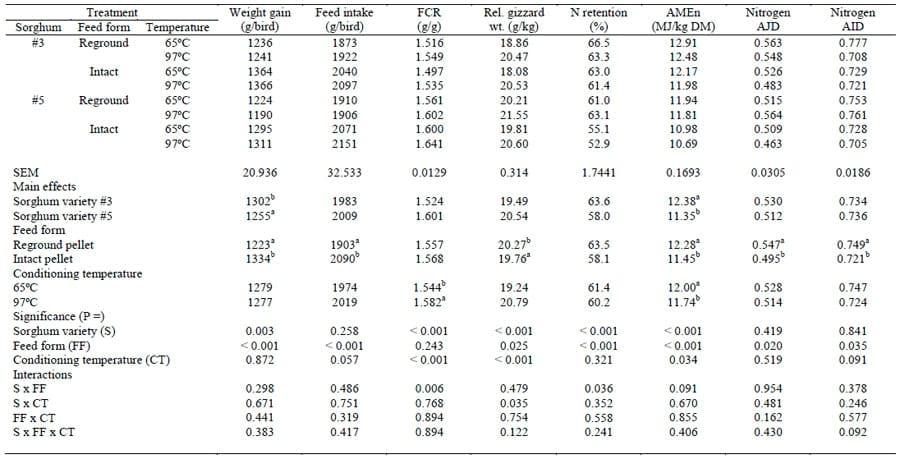Steam-Pelleting Temperatures, Sorghum Variety and Feed Form Influence Growth Performance, Nutrient Utilisation and Nitrogen Digestability in Broiler Chickens
Published: May 31, 2013
By: P.H. Selle, T.J. Gill and A.J. Cowieson – University of Sydney, Australia
Summary
An increase in conditioning temperatures at which diets based on two sorghum varieties were steam-pelleted from 65 to 97°C reduced protein solubility and significantly depressed feed efficiency and the two parameters were correlated (r2 = 0.322). Broilers offered intact pellets had significantly higher feed intakes and weight gains than birds on reground mash but nutrient utilisation was compromised. Sorghum #3-based diets supported significantly better feed efficiency, weight gain and N retention than sorghum #5, which may have been a consequence of a higher kafirin content in the sorghum #5 variety.
I. INTRODUCTION
Sorghum has a relatively high starch gelatinisation temperature and for this reason sorghum- based broiler diets are often steam-pelleted at high conditioning temperatures to achieve acceptable pellet integrity. While compacted, pelleted diets offer a physical feed form advantage over mash diets as they facilitate prehension and increase feed intakes (Jensen et al., 1962), high conditioning temperatures may have adverse effects on the nutritive qualities of pelleted diets (Raastad and Skrede, 2003) and sorghum is especially vulnerable to hydrothermal processes (Selle et al., 2010). To investigate these aspects equivalent diets based on two selected sorghum varieties were steam-pelleted at 65 or 97°C and offered to broiler chicks as intact pellets or reground mash from 7-28 days post-hatch.
II. METHODS AND MATERIALS
This section is abbreviated because the methodology of the present study is essentially similar to a parallel study reported by Selle et al. (2012). Six red sorghum varieties from the 2009 Liverpool Plains harvest were evaluated in a previous feeding study and two were selected for the present experiment. Sorghum #3 contained (g/kg) 112 protein, 712 starch, 8.33 phytate with a Symes' particle size index (PSI) texture of 10 and sorghum #5 contained 126 protein, 700 starch, 8.51 phytate with a PSI texture of 9. With soybean and canola meals, the two sorghums were incorporated into nutritionally equivalent diets with an energy density of 12.8 MJ/kg and 215 g/kg protein and 4.5 g/kg nonphytate P. These diets were steampelleted at 65 or 97°C and offered from 7-28 days post-hatch as intact pellets or reground mash as a 2 x 2 x 2 factorial array of dietary treatments. Each of the eight treatments consisted of six replicates of six male Ross 308 chicks per cage. Parameters assessed included growth performance, relative gizzard weights, N retention, N-corrected AME and apparent N digestibility in the distal jejunum and distal ileum. The protein solubilities of sorghum per se, unprocessed and steam-pelleted diets were determined by the Promatest method, as described by Odjo et al. (2012), which compares the solubility of the feedstuff or test diet with albumin as the 100% soluble standard.
III. RESULTS AND DISCUSSION
Steam-pelleting the #3 sorghum-based diet reduced its Promatest protein solubility from 53.3% to 46.3% at 65°C and 35.5% at 97°C; the corresponding values for sorghum #5 were 50.0, 42.4 and 31.4%. The results of the feeding study are tabulated and the overall 7-28 day weight gain of 1278 g/bird was inferior to the 1553 g/bird performance objective for male Ross 308 chicks. Three significant interactions between main effects were observed and the most notable was the sorghum variety and feed form interaction (P < 0.01) for efficiency of feed conversion. Birds on sorghum #5 diets had higher FCR with pelleted diets; whereas, sorghum #3 birds had lower FCR on pelleted diets. As expected, broilers offered diets based on sorghum #3 significantly outperformed their sorghum #5 counterparts in feed efficiency by 4.8% (1.524 versus 1.601; P < 0.001), weight gain by 3.7% (1302 versus 1255 g/bird; P < 0.01) and N retention by 5.6 percentage units (63.6 versus 58.0%; P < 0.05). This was expected because sorghum #3 per se held advantages in protein solubility (49.5% versus 41.2%), pepsin digestibility (65.8 versus 61.6%) and probably contained less kafirin. Sorghum #3 had an estimated kafirin content 58.0 g/kg and a 'kafirin index' of 4.3; whereas, sorghum #5 contained an estimated 68.1 g/kg kafirin with an index of 6.8. The kafirin index is calculated from sorghum NIR aminograms [g/kg: leucine – (arginine +histidine + lysine)] on the premise that kafirin is rich in leucine but contains a paucity of basic amino acids (Mosse et al., 1988). Alternatively, phytate levels and grain textures of both sorghums were similar.
Diets fed as intact pellets generated significant increases of 9.8% in feed intake and 9.1% in weight gain relative to reground mash diets. However, N retention was significantly decreased by 5.4 percentage units, AMEn by 0.83 MJ and jejunal and ileal N digestibility by 9.5 and 3.7%, respectively. Thus it appears that the substantially higher feed intake of intact pellets compromised nutrient utilisation presumably as a result of 'overconsumption'.
Elevating conditioning temperatures from 65 to 97°C increased relative gizzard weights by 4.0% (20.79 versus 19.24 g/kg; P < 0.001), AMEn by 0.26 MJ (11.74 versus 12.00 MJ/kg; P < 0.05) but, importantly, depressed feed efficiency by 2.46% (1.582 versus 1.544; P < 0.001). As a main effect, conditioning temperatures did not influence (P > 0.50) jejunal N digestibility but when intact pelleted diets are considered separately, there was a quite substantial numerical reduction of 8.7% (0.473 versus 0.518; P < 0.07) that approached significance.
Steam-pelleting diets at 97°C reduced average protein solubility from 51.7% in unprocessed diets to 33.5%. However, it was previously determined that steam-pelleting the two sorghums individually at 90°C reduced their average protein solubility from 45.4 to 13.2%. Therefore, it may be deduced that the average reduction in protein solubility of sorghum per se was from 45.4 to 13.2%; as opposed to the reduction from 55.0 to 44.1% for the balance of proteins in the diet. Thus steam-pelleting generated a considerably more pronounced reduction in sorghum protein solubility than in soy and canola proteins. Pearson correlations between dietary protein solubilities and the in vivo parameters assessed are instructive. Protein solubility was significantly correlated with feed conversion ratios (r = - 0.567; P < 0.001), AMEn (r = 0.384; P < 0.01) and tended to be correlated with N retention (r = 0.266; P < 0.10). When only intact pelleted diets are considered, protein solubility was correlated with feed conversion ratios (r = -0.557; P < 0.01), AMEn (r = 0.447; P < 0.05), N retention (r = 0.447; P < 0.05) and jejunal N digestibility (r = 0.423; P < 0.05).
It was established in a previous study (Selle et al., 2012) that in the order of 30% of the reduction in protein solubility generated by steam-pelleting sorghum-based diets can be attributed to the formation of disulphide bridges. The likelihood is that this mainly occurred between cysteine residues in the γ- and β-kafirin fractions located in the periphery of protein bodies in sorghum endosperm, which is thought to impede digestion of the central α-kafirin core (Duodu et al., 2003). Therefore, in diets fed as intact pellets it is relevant that the increase in conditioning temperatures numerically reduced jejunal N digestibility from 0.518 to 0.473 and this reduction was significantly correlated to protein solubility of the diets.
Finally, steam-pelleting two sorghum-based diets at 65°C and 97°C reduced protein solubility and the increase in conditioning temperatures significantly depressed feed efficiency by 2.5% (1.582 versus 1.544). Protein solubilities were significantly correlated with feed conversion ratios (r2= 0.322), which indicates that the Promatest method may be a valuable indicator. Diets based on sorghum #3 outperformed sorghum #5 by 4.8% in feed efficiency, 3.7% in weight gain and 5.6 percentage units in N retention and in its native state sorghum #3 was higher in both protein solubility and pepsin digestibility. While phytate, starch, protein levels and grain texture of the two sorghums were similar there is the likelihood that sorghum #5 contained more kafirin, which may have contributed to the differences observed in broiler performance.
ACKOWLEDGEMENTS: The financial support provided by RIRDC Chicken-meat Committee for the sorghum steam-pelleting temperature project, of which this study formed a part, is gratefully acknowledged.
REFERENCES
Duodu KG, Taylor JRN, Belton PS, Haymaker BR (2003) Journal of Cereal Science 38, 117- 131.
Jensen LS, Merrill LH, Reddy CV, McGinnis J (1962). Poultry Science 41, 1414-1419.
Raastad N, Skrede A (2003) Proceedings, 14th European Symposium on Poultry Nutrition pp 115-116.
Mosse J, Huet J-C, Baudet J (1988) Cereal Chemistry 65, 271-277.
Odjo S, Malumba P, Dossou J, Janas S, Bera F (2012) Journal of Food Engineering 109, 561-570.
Selle PH, Gill RJ, Downing JA (2010) Proceedings, Australian Poultry Science Symposium 21, 68-71.
Selle PH, Liu SY, Cae J, Cowieson AJ (2012) Animal Production Science (doi: 10.1071/AN12026).
Table 1 - Effects of dietary treatments on growth performance, relative gizzard weights, nutrient utilisation and apparent nitrogen digestibility coefficients in the distal jejunum (AJD) and distal ileum (AID) from 7 to 28 days post-hatch
Related topics
Authors:
Join to be able to comment.
Once you join Engormix, you will be able to participate in all content and forums.
* Required information
Would you like to discuss another topic? Create a new post to engage with experts in the community.
Create a post







.jpg&w=3840&q=75)